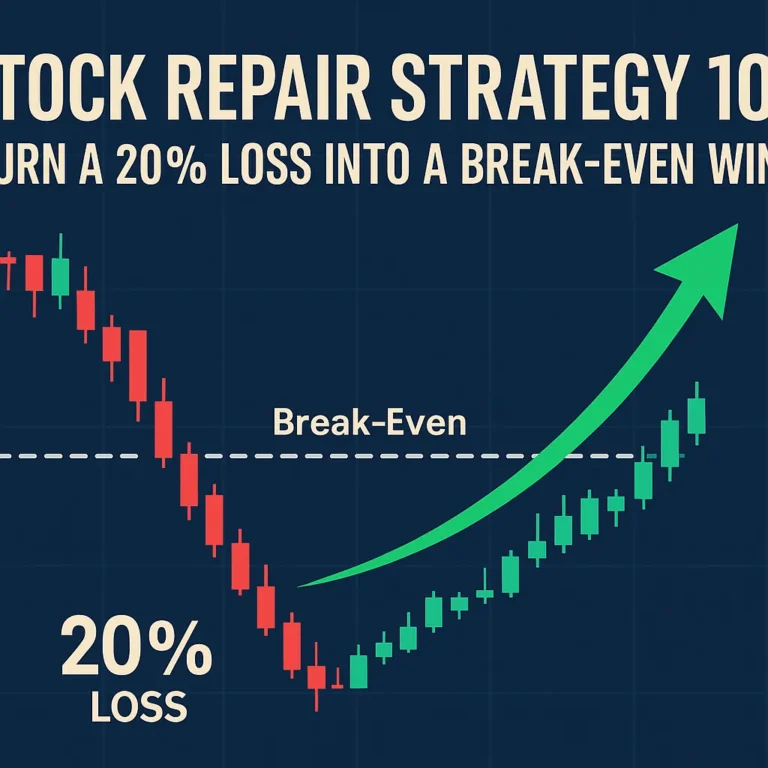
Stock Repair Strategy 101: Turn a 20% Loss into a Break-Even Win
Quick Summary
Down ~20% on a position? This primer introduces a practical Stock Repair Strategy designed to help you target a break-even exit without adding new cash. You’ll learn when it works best (typically 15–25% drawdowns), how to assess recovery potential, and how to prepare for the steps we’ll implement next.
Stock Repair Strategy 101: Turn a 20% Loss into a Break-Even Win
Goal: Stabilize a losing trade and engineer a path to neutral (or better) while preserving capital and decision-making flexibility.
Understanding the Stock Repair Strategy Start Here
What it is: A disciplined approach for positions that are underwater by roughly 15–25%, where the underlying business still has credible recovery potential. Rather than throwing good money after bad, you define a break-even target and align your tactics to reach it efficiently.
Why it can work: Many drawdowns are not permanent. If fundamentals stabilize and catalysts emerge, a structured repair plan helps you maximize the next bounce and reclaim your initial basis faster than passively waiting.
Before anything else, re-ground your thinking in valuation. If you need a refresher, revisit this explainer on how to evaluate the real value of a stock.
✅ Benefits
- Capital-efficient: Targets break-even without adding fresh cash.
- Psychological clarity: Replaces panic with a defined exit plan.
- Portfolio hygiene: Frees mental bandwidth to focus on higher-conviction ideas.
❌ Limitations
- Not a cure-all: Avoid if the company’s trend and fundamentals are deteriorating.
- Execution risk: Requires attention and discipline; poor timing can delay recovery.
Mindset check: If news quality is worsening, consider studying how to filter signals from noise. See this primer on identifying bad stock news to avoid repairing a fundamentally broken story.
Investopedia — Understanding Loss Recovery
Clear overview of why recovering from a drawdown requires a larger % gain.
Link type: dofollow
CFA Institute — Portfolio Management Basics
Concepts that reinforce the math and discipline behind repair decisions.
Link type: nofollow
Am I a good candidate for a repair?
- You’re down ~20% on a quality name and new, credible catalysts exist.
- Position size is contained; you can hold through a structured recovery window.
- You’ve revisited the basics (valuation, news flow, risk stats). For a foundation, see Fundamentals of Stock Market Investing.
Real-life vignette: An investor bought a quality semiconductor stock, then watched it slide 19% on macro jitters. Instead of selling in frustration, they set a break-even target, monitored the next earnings date, and aligned their exit with a relief rally — neutralizing the position and reallocating to a higher-conviction setup.
- Stock repair is about precision and discipline, not hope.
- Works best for 15–25% drawdowns where fundamentals can stabilize.
- Define break-even early and align tactics to that price.
Up next: we’ll decide when to deploy repair vs. when to cut a position and reallocate.
For readers who anticipate using options within a repair framework, you’ll later explore basics here: Covered vs. Uncovered Calls.
Prefer to compare trading styles while you wait for a repair to play out? This overview helps: Day Trading vs. Swing Trading.
When and Why to Use the Stock Repair Strategy
A repair strategy is not a tool for every losing position. It shines in very specific market situations where the probability of recovery is high, and your capital is better preserved for that bounce instead of a fresh trade.
Signals That Stock Repair May Be Worth Attempting
- Fundamental Stability: Earnings are holding steady or improving, even if price dipped temporarily.
- Sector Strength: Industry peers are trending higher, suggesting your stock’s weakness may be temporary.
- Upcoming Catalysts: Events like product launches, earnings calls, or analyst upgrades could trigger recovery.
- Technical Support: The stock is hovering above a strong historical support level.
Before committing, study recent market news flow. If negative sentiment is likely to persist, you may be better served exploring other strategies. Review how to identify bad stock news to avoid repairing stocks with no recovery prospects.

Real-Life Example
In 2023, a mid-cap renewable energy company dropped 18% after a temporary earnings miss. Analysts maintained a “Buy” rating, citing upcoming government incentives. Using a repair strategy, the investor sold covered calls, setting a break-even target just above the cost basis. Within three months, the stock recovered and the investor exited neutral, freeing up capital for a [swing trading opportunity](https://tradestockalerts.com/swing-trading-success-stories/).
✅ Best Scenarios for Repair
- Drawdown of 15–25% on a fundamentally sound stock.
- Upcoming catalysts likely to push price upward.
- Technical analysis shows strong support levels nearby.
❌ Avoid Repair If…
- Stock is in a secular downtrend with worsening fundamentals.
- Liquidity is thin, making options pricing inefficient.
- You lack time or skill to actively manage the trade.
MarketWatch — Stock Repair Strategies
Practical market scenarios where a repair plan makes sense.
Link type: dofollow
The Motley Fool — Stock Repair Strategy Guide
Beginner-friendly breakdown of the pros and cons of repairing a stock.
Link type: nofollow
Mindset Before Deployment
Think of a stock repair trade as a capital rescue mission, not a home run attempt. The goal is to recover your initial investment — nothing more. This mindset keeps you disciplined and prevents overtrading.
- Deploy repair only when recovery probability is backed by fundamentals and catalysts.
- Use technical and sentiment checks to confirm timing.
- Set clear break-even targets before entering the repair trade.
How the Numbers Work in a 20% Loss Recovery
Here’s the essential math behind a break-even exit. If your stock falls by 20%, you don’t need a 20% rebound — you need a 25% gain from the new (lower) price to return to even. Understanding this asymmetry keeps expectations realistic and shapes your repair tactics.
The Core Break-Even Formula
Start price = P. After a loss of L%, the new price is P × (1 − L).
To break even, we need a gain of G% such that:
P × (1 − L) × (1 + G) = P ⇒ (1 + G) = 1 / (1 − L) ⇒
G = L / (1 − L).
- L = 10%: G = 10% / 90% = 11.11%
- L = 20%: G = 20% / 80% = 25.00%
- L = 30%: G = 30% / 70% = 42.86%
Loss vs. Required Gain Table
Use this as a quick reference when planning your break-even target.
| Loss (%) | Required Gain to Break Even (%) |
|---|---|
| 5 | 5.26 |
| 10 | 11.11 |
| 15 | 17.65 |
| 20 | 25.00 |
| 25 | 33.33 |
| 30 | 42.86 |
| 35 | 53.85 |
| 40 | 66.67 |
| 50 | 100.00 |
| 60 | 150.00 |
Practical Implications for Your Repair Plan
- Define break-even precisely: Know the exact price that returns your basis to zero.
- Use catalysts to your advantage: Earnings, guidance updates, or sector tailwinds can compress the timeline to break-even.
- Size and time the exit: Scale out near the target to lock in the repair if volatility is high.
Need a refresher on core principles before you number-crunch? Start with the Fundamentals of Stock Market Investing.
To understand why some prices snap back faster than others, explore how activity can drive moves: How a Stock’s Volume Can Affect Its Price.
Investopedia — Loss Aversion
Behavioral bias that can derail repair plans if not managed.
Link type: dofollow
Investor.gov (SEC) — Understanding Risk
Official guidance on risk and expectations when managing losses.
Link type: nofollow
✅ Numerical Advantages
- Clarity: A fixed break-even percentage avoids wishful thinking.
- Discipline: Math-driven targets make exits easier to execute.
❌ Numerical Pitfalls
- Moving targets: Further declines raise the required gain dramatically.
- Volatility traps: Choppy rallies can miss your exact target if you don’t scale.
- G = L / (1 − L) is the break-even recovery formula.
- A 20% loss needs a 25% gain from the reduced price to break even.
- Let the math inform where and how you plan your exit.
Next up: we’ll translate this math into a step‑by‑step execution plan for your repair trade.
Executing the Stock Repair Trade
Your objective is simple: engineer a break-even exit on a position that’s down ~15–25% — ideally without adding new cash. Below is a disciplined playbook you can adapt to your risk tolerance and time horizon.

Pre-Trade Checklist
- Story still viable? Confirm revenue/earnings trajectory, liquidity, and balance-sheet stability.
- Near-term catalysts? Earnings, guidance updates, product launches, or sector tailwinds.
- Technical context: Identify support/resistance and average true range (ATR) for realistic targets.
- Exit defined: Exact break-even price and time window to attempt the repair.
Re-ground on option basics before using calls within a repair plan: Covered vs. Uncovered Calls.
Step-by-Step Execution (Core Flow)
- Diagnose the drawdown: Identify whether the drop was idiosyncratic (company-specific) or systemic (sector/market). If it’s systemic but temporary, odds of a bounce improve.
- Fix your break-even target: Calculate the exact price required to return your basis to zero. Anchor alerts there.
- Choose your tactic:
- Passive repair: Hold for the bounce if catalysts are imminent and implied volatility (IV) is elevated.
- Options-aided repair: For holders of 100+ shares, consider selling covered calls near the break-even strike to collect premium while waiting for the move.
- Time the entry: Use support tests, moving averages, and event calendars. Avoid initiating just before binary events unless that is part of the plan.
- Scale the exit: As price approaches your break-even level, stagger sells (e.g., 25–50–25%) to lock the repair during volatility.
- Post-trade hygiene: Journal what worked, what didn’t, and whether you ignored any signals. This reduces repeat mistakes.
Options-Aided Repair (Illustrative)
Scenario: You own 200 shares at a $100 cost basis. Stock trades at $80 (−20%). Break-even requires a ~25% rebound to $100.
- Sell 2 covered calls with a $100 strike expiring after the next catalyst. The premium collected reduces the effective distance to break-even.
- If the stock rallies toward $100, you can be called away at break-even (plus premium), or roll the calls if you decide to hold longer.
- If price stalls, premium still offsets part of the drawdown; reassess after earnings/update.
This is not a one-size-fits-all solution. Low-liquidity names or very high borrow costs can make option pricing inefficient.
✅ Advantages of Options-Aided Repair
- Premium income shortens the distance to break-even.
- Defined target around your cost basis improves discipline.
- Can be repeated across cycles if the story remains intact.
❌ Considerations & Risks
- Upside capped: Covered calls limit gains above the strike.
- Assignment risk: Shares can be called away, including early around ex-dividend dates.
- Event risk: Earnings or guidance cuts can invalidate the thesis.
Alternative Paths While You Wait
Some traders prefer to keep capital active elsewhere while a repair unfolds. Compare styles in Day Trading vs. Swing Trading, or review real outcomes in Swing Trading Success Stories.
Cboe — Options Education Center
Authoritative lessons on covered calls, rolling, and assignment mechanics.
Link type: dofollow
OCC — Options Education
Foundation concepts and risk disclosures to refine your repair plan.
Link type: nofollow
- Define break-even precisely and align tactics to that target.
- Consider covered calls to harvest premium while awaiting a bounce.
- Scale exits near the target to lock the repair amid volatility.
Next: we’ll walk through real-life case studies showing stock repair in action across different sectors.
Case Studies: Real-Life Stock Repair in Action
Theory is useful — but seeing the Stock Repair Strategy applied in real scenarios shows how it works in practice. These case studies highlight different approaches and outcomes, giving you a clearer sense of when the strategy delivers and when to move on.
Case Study #1 — Tech Sector Recovery via Covered Calls
Background: In early 2024, a cloud software company fell 19% after missing quarterly revenue estimates. The drop was primarily due to delayed enterprise contracts, not fundamental weakness.
Repair Tactic: The investor, holding 300 shares, sold three covered calls at the original $150 cost basis strike, expiring after the next earnings release. The premiums reduced the break-even level by $4 per share.
Outcome: Three months later, the company announced renewed contracts and upbeat forward guidance. The stock rallied to $151, the calls were assigned, and the investor exited break-even plus premium income.
For further reading on how news impacts price action, see How to Identify Bad Stock News.
Case Study #2 — Energy Stock Bounce from Macro Catalysts
Background: A mid-cap renewable energy stock dropped 22% due to a temporary reduction in government subsidies. However, legislation was pending to reinstate these incentives.
Repair Tactic: The investor set a break-even exit target of $40 and waited for legislative updates. No options were used — the strategy here was purely holding for the catalyst.
Outcome: Within four months, the subsidy package passed, sparking a sector-wide rally. The stock climbed to $42, and the investor exited with a small net gain after commission costs.
For a deeper dive into turning points in sector sentiment, review Swing Trading Success Stories.
Bloomberg Markets — Sector Trends
Track the industry-level movements that can accelerate stock repair opportunities.
Link type: dofollow
Reuters — Business News
Stay ahead of catalysts that could affect your portfolio’s recovery trajectory.
Link type: nofollow
✅ Lessons from Successes
- Both stocks had clear, identifiable catalysts for recovery.
- Investor discipline ensured exits occurred at planned levels.
- Risk was managed by not doubling down with more capital.
❌ Cautionary Points
- Repair timelines can extend, tying up capital longer than expected.
- External events (e.g., policy changes) can work for or against you.
- Repair works best when fundamentals and catalysts align.
- Options can speed up break-even but aren’t mandatory for success.
- Patience and adherence to pre-set exit targets are critical.
Next, we’ll explore the risks, limitations, and tax implications every investor should weigh before committing to a repair trade.
Risks, Limitations, and Tax Implications
The Stock Repair Strategy can be a valuable tool, but it’s not without its risks. Understanding the limitations — and the potential tax angles — ensures you deploy it intelligently and avoid costly mistakes.

Common Pitfalls
- Repairing the wrong stock: If the fundamentals are broken, even perfect execution won’t help.
- Overextending the timeline: A drawn-out repair can tie up capital for months or years.
- Ignoring opportunity cost: Money tied in a slow recovery could have been deployed in a stronger setup.
- Volatility traps: Short-lived rallies may miss your target; without scaling exits, you can watch gains evaporate.
When evaluating whether a stock is worth repairing, consider your opportunity cost and alternative setups like Penny Stock Alerts for higher-momentum trades.
Tax Implications
One often-overlooked benefit of exiting a losing position is the ability to harvest capital losses for tax purposes. Depending on your jurisdiction, you may offset gains or deduct a portion of losses against income.
- Tax-loss harvesting: Selling a losing position to offset taxable gains elsewhere in your portfolio.
- Wash sale rule: In the U.S., you cannot repurchase the same security within 30 days before or after the sale if you want to claim the loss.
- Offsetting gains: Losses can reduce taxable capital gains, potentially lowering your tax bill.
Always verify details with a tax professional — rules vary. The IRS outlines these principles clearly in its capital gains/loss guidance.
IRS — Capital Gains and Losses
Official guidance on recognizing and reporting gains and losses for tax purposes.
Link type: nofollow
Investopedia — Tax-Loss Harvesting
Comprehensive overview of how to use capital losses strategically.
Link type: dofollow
✅ Potential Advantages
- Opportunity to use tax-loss harvesting for portfolio benefit.
- May preserve original investment without adding more capital.
- Can maintain a position in a fundamentally sound company during recovery.
❌ Risks & Limitations
- May tie up capital for extended periods.
- Potential to miss out on better opportunities elsewhere.
- Market conditions can deteriorate unexpectedly, invalidating the repair plan.
- Not all losing stocks are worth repairing — fundamentals matter most.
- Factor in the opportunity cost of capital during the repair period.
- Understand tax rules to avoid disqualifying potential write-offs.
Next, we’ll wrap up with a consolidated set of key takeaways, expert advice, and FAQs to help you apply the Stock Repair Strategy with confidence.
Key Takeaways, Expert Advice & FAQs
After covering the theory, execution, and real-world results of the Stock Repair Strategy, here’s a concise wrap-up to guide your next move when facing a drawdown.
- Works best for losses of 15–25% on fundamentally sound stocks with recovery potential.
- Always define your break-even price and exit plan before initiating the repair.
- Use catalysts, technicals, and (optionally) covered calls to shorten the path to recovery.
- Be mindful of opportunity cost and know when to cut and reallocate capital.
- Tax-loss harvesting can turn a loss into a strategic advantage.
Expert Advice
- Be selective: Only repair positions with viable fundamentals. Avoid stocks in long-term structural decline.
- Track catalysts: Earnings dates, sector news, and macro factors can accelerate or derail a repair.
- Manage risk actively: Use scaling exits and protective stops when volatility is high.
- Stay educated: Deepen your knowledge through resources like Fundamentals of Stock Market Investing and Day Trading vs. Swing Trading.
Frequently Asked Questions
Q: Does the Stock Repair Strategy work for penny stocks?
A: It can, but liquidity, volatility, and wider bid-ask spreads make it riskier. Consider higher-momentum plays like Penny Stock Alerts for faster moves.
Q: What if the stock drops further after I start the repair?
A: Reassess the fundamentals. If the thesis is broken, cutting losses may preserve more capital than continuing the repair.
Q: Is this a beginner-friendly strategy?
A: Yes, but only with a clear plan. Beginners should practice on paper trades or smaller positions before scaling up.
Q: How long should I hold during a repair?
A: Duration depends on the catalyst timeline and volatility. Some repairs resolve in weeks; others may take months.
Investopedia — Stock Repair
Detailed explanation of the mechanics behind stock repair trades.
Link type: dofollow
Fidelity — Stock Repair Strategy
Step-by-step guide to implementing stock repair using covered calls.
Link type: nofollow
✅ Advantages of Applying This Strategy
- Can recover initial capital without adding more funds.
- Improves portfolio discipline and trade planning.
- Potential tax benefits through loss harvesting.
❌ Risks & Watch-Outs
- May tie up capital longer than expected.
- Not suitable for all market conditions or all stocks.
- Requires active monitoring to capture the exit window.
With these insights, you now have a full blueprint for deploying the Stock Repair Strategy with confidence — knowing when to act, when to hold, and when to move on.